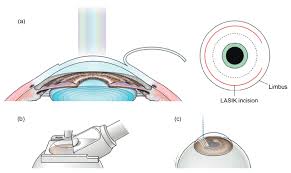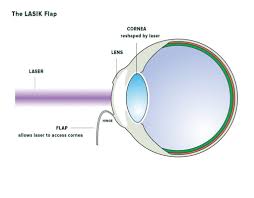Table of Contents
ToggleA weak cornea after LASIK may result from structural changes in the cornea during surgery or pre-existing conditions that went unnoticed before the procedure.
While LASIK is generally safe, some risks are associated with altering the cornea’s shape and thickness.
This blog explores the potential reasons behind corneal weakness after LASIK, shedding light on its causes, risks, prevention, and what can be done if you suspect your cornea has been affected.
Understanding the Corneal Structure and LASIK Procedure
What happens to the cornea during LASIK?
LASIK (Laser-Assisted in Situ Keratomileusis) is a popular refractive surgery designed to correct vision problems such as myopia, hyperopia, and astigmatism. During this procedure, a thin flap is created on the cornea’s surface, which is lifted to allow access to the underlying corneal tissue. A laser then reshapes this tissue to correct refractive errors, after which the flap is repositioned.
This reshaping can lead to a reduction in corneal thickness, which in some cases may weaken its structural integrity. The extent of this alteration may depend on factors such as the preoperative thickness of the cornea and the amount of correction required.
Why is corneal strength important?
The cornea serves as the eye’s primary refracting surface and a protective barrier against external damage. For it to perform these functions effectively, it must maintain a certain thickness and biomechanical stability. Weakening of the cornea can lead to long-term complications, including bulging or distortions in its shape.
Key Point: Changes made during LASIK can reduce corneal thickness in a way that might compromise its strength in certain individuals.
Causes of Corneal Weakness After LASIK
1. Excessive Thinning of the Cornea
One of the most common reasons for corneal weakness after LASIK is excessive thinning. The amount of corneal tissue that can be safely removed is limited. If the surgeon reshapes too much of the cornea, it can compromise its biomechanical properties and lead to structural instability.
2. Pre-existing Conditions
Certain underlying conditions, such as keratoconus, can predispose someone to corneal weakness post-LASIK. Keratoconus is a condition where the cornea thins and bulges into an irregular shape. Even if diagnosed early or present in its mildest form, undergoing LASIK without accounting for such issues can exacerbate corneal instability.
3. Improper Candidate Selection
Not everyone is a perfect candidate for LASIK. People with:
- Thin corneas
- High refractive errors
- Dry eye syndrome
are at greater risk of corneal complications. If these factors are overlooked during the preoperative evaluation, complications like corneal weakness may arise.
4. Corneal Ectasia
Corneal ectasia is one of the rare but significant complications of LASIK. It occurs when the cornea becomes progressively thinner and bulges outward after surgery. This condition can lead to distorted vision and may recur years after LASIK if left untreated.
Bold Insight: Early detection and management of corneal ectasia are crucial to prevent long-term visual impairment.
5. Healing Variability
Each person’s cornea heals differently after LASIK. Factors such as age, collagen density, and overall eye health can influence how well the cornea regains its strength post-surgery. Delayed or improper healing can result in lingering corneal weakness.
Signs and Symptoms to Watch For
It’s vital to recognise the signs of corneal weakness to seek timely intervention. Common symptoms include:
- Blurred or distorted vision
- Sensitivity to light
- Eye pain or discomfort
- Difficulty focusing on objects
- Decreased visual sharpness, especially at night
If you experience these symptoms after LASIK, it is crucial to contact your ophthalmologist immediately.
Can Corneal Weakness Be Prevented?
1. Thorough Preoperative Evaluation
Before undergoing LASIK, your eye care provider should conduct a comprehensive evaluation, including corneal topography, pachymetry (measuring corneal thickness), and an assessment of your refractive error. Identifying any pre-existing issues is key to reducing surgical risks.
2. Advanced LASIK Techniques
Newer LASIK technologies use advanced mapping systems that minimise tissue removal while achieving better visual correction. If you’re a borderline candidate due to corneal thickness or steepness, discuss these options with your surgeon.
3. Customised Treatment Plans
Surgeons can create personalised treatment protocols adapted to the unique anatomy and needs of your eyes. Custom LASIK, for example, takes into account corneal irregularities to correct vision more precisely while preserving as much corneal thickness as possible.
4. Post-Surgical Care
Adhering to follow-up appointments and recommended post-operative guidelines can significantly improve outcomes. Proper use of medications, such as lubricating drops, and avoidance of eye trauma during recovery will help the healing process.
Tip: Always ask your surgeon about your corneal thickness and how much tissue is safe to remove before the procedure.
What Are the Treatment Options for Weak Corneas?
If you have developed a weak cornea post-LASIK, several treatment options may help restore stability and vision:
1. Corneal Collagen Cross-Linking (CXL)
This minimally invasive procedure strengthens the cornea by applying ultraviolet light and riboflavin (vitamin B2). It’s commonly used for treating corneal ectasia and stopping its progression.
2. Specialised Contact Lenses
Scleral or gas-permeable contact lenses can reshape the optical surface of the eye, improving vision while protecting the cornea.
3. Corneal Transplants
Severe cases of corneal weakness might require a partial or full-thickness corneal transplant. This is typically a last resort but is effective for restoring corneal structure and vision.
4. Intacs (Corneal Implants)
Plastic inserts placed into the cornea can reshape and stabilise its surface, making it more regular and reducing visual symptoms.
5. Regular Monitoring
For mild cases, regular monitoring and reinforcement of preventive care may be sufficient.
Good to Know: Treatment outcomes largely depend on early diagnosis and individualised care plans.
The Role of Patient Education
Being informed about the risks and benefits of LASIK is the foundation for better surgical outcomes. If you’re considering LASIK, don’t hesitate to ask questions such as:
- What are my corneal health metrics (thickness, regularity, etc.)?
- Am I at risk for corneal ectasia based on my eye anatomy?
- Are there alternative procedures more suitable for my eyes?
Ensuring that both you and your surgeon have a clear understanding of potential complications will go a long way in preventing issues like corneal weakness.
Final Thoughts on Weak Corneas After LASIK
LASIK remains one of the most effective and commonly performed vision correction surgeries today. However, corneal weakness is a rare but real complication. Understanding the causes, recognising the symptoms, and taking preventive measures can ensure better surgical outcomes.
If you’ve already had LASIK and suspect corneal issues, don’t delay getting professional advice. A robust post-surgery care plan often makes all the difference.
For those considering LASIK, choose your surgeon and clinic carefully—they should prioritise the health and safety of your eyes over all else. Remember, your vision is precious!













